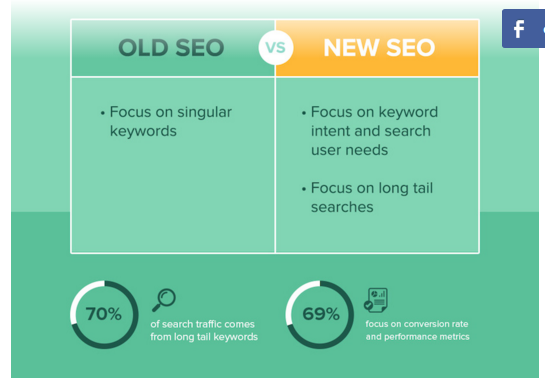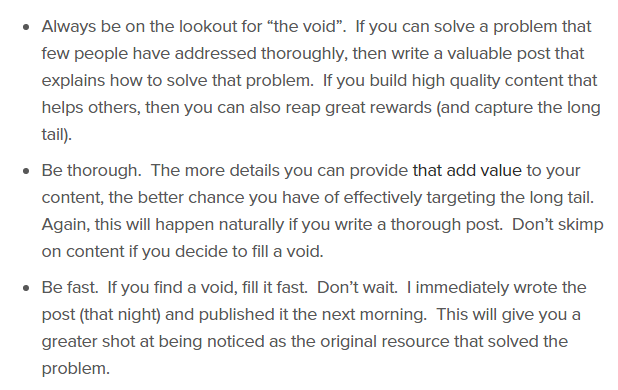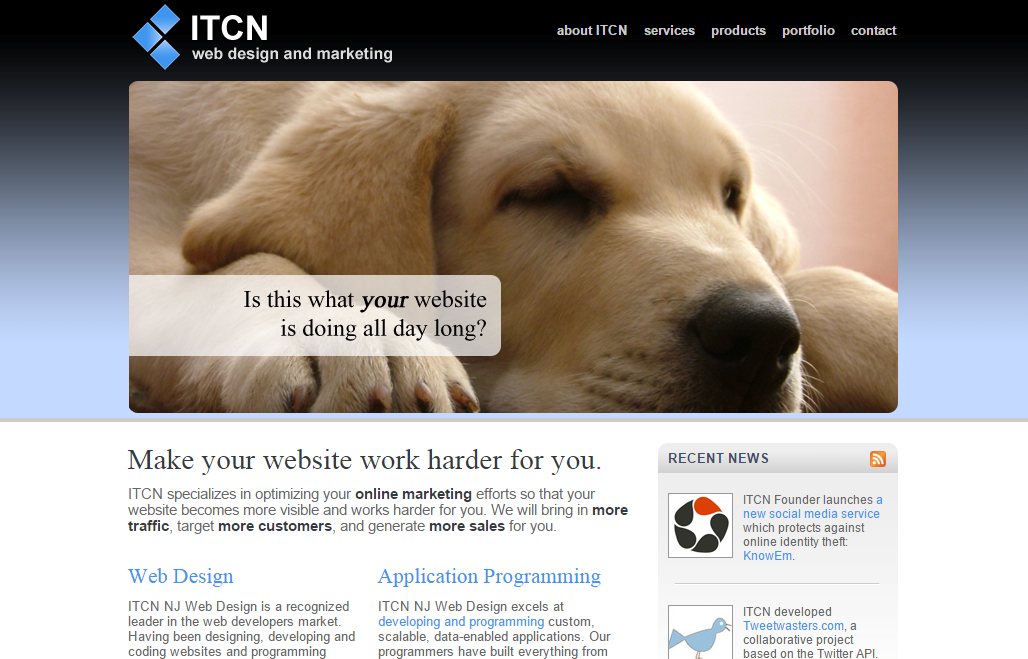7 Brilliant Examples of Brands Driving Long-Tail Organic Traffic
There’s no doubt that long-tail keywords are popular among content marketers, bloggers and SEOs. The reason for that is simple: consumers are using long-tail keywords and are more likely to buy when they do.
In fact, one study by Vabrion found that 70% of search queries are long tail and that long-tail keywords convert 2.5x more frequently.
If you want to get the most out of search engines, focus on longer variations of the head keywords.
For example, instead of targeting “running shoes,” which is highly competitive, you can rank highly if you target “best women’s nike shoes” in your title and create truly useful content around that keyphrase.
The majority of brands that researched and targeted long-tail search terms have experienced a leap in organic traffic and rankings, but that doesn’t mean you won’t experience challenges.
Truth be told, if you want an immediate organic traffic boost, creating content around long-tail search phrases probably won’t get you there.
But, your focus should be on the long-term. That’s when your web pages start showing up in results, even for keywords you didn’t primarily target.
If you’re willing to play the long game, long-tail keywords can increase your organic traffic and convert better than head terms.

In this in-depth post, I’ll show you 7 brilliant examples of brands that are driving long-tail organic traffic. Send this guide to your team or clients to convince them that long-tail search is the future of SEO, for both B2B and B2C companies.
Download this cheat sheet of 7 brilliant examples where brands are driving long-tail organic traffic.
Let’s get started with Amazon, the number #1 ecommerce store in the world:
1. Amazon Makes 57% of Sales From Long-Tail Keywords
As the #1 shopping site in the world, Amazon generates a lot of book sales thanks notably to long-tail product descriptions. Search Engine Guide found that Amazon generates 57% of its sales from long-tail searches.

Chris Anderson, editor-in-chief of Wired, noted that
The best way to dominate the web in the face of stiff competition is to optimize for long-tail search.
It’s difficult to know the user intent behind head keywords, but much easier when a user inputs a longer variation of any search term.
Simply put, long-tail search is all about optimizing for the most motivated consumers, who define their intention with longer search terms (usually 4 or more words). Long-tail keywords are more targeted search phrases.
Which products perform best online in terms of organic search? Well, products you can’t find in offline stores perform well online – that’s why consumers search for them on the web.

The good thing about this keyword type is that it contains the more generic head keyword, but it also contains modifiers or extra words that make it relevant to a more specific audience films met torrents.
For example, “clothing” is an undefined head keyword. It may have a lot of searches, but it isn’t targeted. And, if you run a clothing blog, it may be difficult to compete with the larger authority sites.
On the other hand, “top men’s clothing brand” is better defined and caters to a very specific audience, i.e. men looking for the top clothing brands.
Still using Amazon as a case study, have you noticed that when you type in any product-related keyword in Google, Amazon’s results usually stand out?

If you run your own online store, then chances are you know the level of competition that you’re up against. You don’t just compete with Amazon, but also with millions of online stores and affiliate sites targeting the same keywords and trying to rank highly on Google.
Ecommerce store owners know that #1 rankings in Google get an average 36.4% click-through rate, while the second page rankings get a measly 1.5% CTR.

The question isn’t “where do you want your product pages to rank?” Everyone wants the #1 spot. These days, the question is “how can you rank highly for relevant keywords in the face of almost overwhelming competition?”
Fortunately, there’s a way to do just that, for those of us who aren’t Amazon: we can target uncommon keyword phrases and still dominate our market.
Amazon’s sales have long been on an upward growth trend that correlates to the company’s decision to embrace long-tail optimization.

Taking the same approach will help you rank highly in Google, generate consistent sales and build a sustainable business online.
Google reports that 15% of the search queries performed on its site are completely unique — that is, never before seen by Google.
This is good news, because our target audience has made it easier for us to serve them.
It’s estimated that 70% of search traffic is from long-tail keywords, yet a lot of brands still don’t think it’s worth their time or effort. If long-tail keywords are so effective, why are so many brands still ignoring them?

First of all, many of these brands have huge annual marketing budgets of six or even seven figures. For these huge brands, investing in long-tail search may not generate the needed ROI.
Second, long-tail keywords usually have low search volume. You can’t expect to make a huge impact with them, especially when your site is large.
Finally, targeting long-tail search phrases is a long-term endeavor. You can’t expect to rank in the first page for any of these terms overnight, even though they’re not highly competitive.
That’s because Google has changed the rules. Modern SEO is about purpose. In the past, including a keyword of this nature on your title would get you first page rankings within 30 days.

To get that first-page ranking in Google, you still need to create high-quality content, engage the right people and increase your social signals netextender herunterladen.
So while it makes sense for some large brands to ignore long-tail keywords, we as bloggers and marketers of smaller brands can take advantage of it.
You can’t successfully compete with Entrepreneur.com for a head keyword like “small business ideas.”

That keyword “small business ideas” has an average monthly search volume of over 22,000 and attracts a target group of people who are seeking viable ideas to help them build a business.

But you can complement what Entrepreneur.com has done by creating more useful content while targeting other easy-to-rank keywords with a decent search volume.

After all, when you search for “work from home ideas,” you won’t find Entrepreneur.com on the first page.

So, there are lots of opportunities to rank highly in Google if you stop trying to compete and start trying to complement.
When you start to complement what other authority sites have done, you’ll start looking for, and finding, hidden opportunities and long-tail keywords that haven’t been targeted. That’s your competitive edge.
When you look at Amazon’s product descriptions, you’ll notice they’re descriptive and contain the product name, model number, color and sometimes the size.

In addition to these descriptive product pages, the customers also provide lengthy, in-depth reviews of each product.

One thing you’ll notice when you do a search is that Google no longer ranks only the exact match to long-tail keywords.
Instead, it ranks pages that are relevant to the search term. After all, the searchers may not have the same exact terms in mind.
So when I search for “men’s wallet with coin compartment,” not all the results I saw targeted that exact title, but the pages are 100% relevant.

Quick tip: If you’re selling a physical (jewelry, watches, etc.), or digital (software, ebook, plugins) product, there’s no need to integrate your targeted long-tail keywords in your title verbatim.
Sure, you should add them if they flow naturally, but keep your focus on creating a richer experience for users when they read your content.
Avoid repeating a particular long-tail keyword over and over. This can get you into trouble, because it’s the perfect definition of keyword stuffing.
When you create a long-form (3000+ words) article, you’ll naturally find a lot of keywords falling into the right place. And before long, your web page will start ranking for several long-tail keywords that you didn’t target.

2. River Pools and Spas Generated $2 Million in Sales
Data from Altimeter found that “70% of marketers lack a consistent content strategy.”
And that’s one of the biggest reasons why B2B content marketing fails herunterladen. Without a strategy, no matter how much effort and time you put into your business, you’ll continue to struggle.

I want to share a brief success story that’ll help you see the potential in your content.
Marcus Sheridan is a highly respected content marketer. He’s achieved tremendous success, and he’s known for his unique teaching style where he makes great use of storytelling.
But it wasn’t always like this.

Marcus had a swimming pool company that was on the brink of going out of business. He’d tried several marketing techniques, doing all he could to acquire high-end leads and clients.
Finally, in a somewhat last-ditch effort to save his business, Marcus embraced inbound and content marketing.
Well-known data points became his reality. According to HubSpot, companies that blog generate 126% more leads than those that don’t.

Marcus worked hard to learn the core principles of inbound marketing and how to build relationships with prospects. And it transformed his business.
River Pools and Spas became one of the most reliable and authoritative swimming pool websites in the world, garnering over 500,000 visitors a month.

The interesting part is that Sheridan didn’t just follow a content marketing recipe.
Instead, he researched his audience and found that majority of them had a single question that had to be answered before they’d purchase: they wanted to know how much a fiberglass pool costs.
At the time, there were only a handful swimming pool websites and they were all about selling – not really helping people or solving their problems.
Sheridan researched long-tail keywords and then created an in-depth blog post entitled “How Much Does a Fiberglass Pool Cost?” This one blog post has generated over $2 million in sales.

By the way, that long-tail search term currently has an average monthly search volume of just 320.

But it’s a decent long tail keyword to go after, especially when you’re selling a high-ticket product like fiberglass swimming pools.
Let’s assume that you run a car comparison site. You want to rank highly for several keywords, but you just can’t seem to manage it. Instead of beating your head against the wall, look for long-tail keywords that your competitors aren’t targeting:
i). First step: Go to Google AdWords Keyword Planner. Input a search string (e.g., honda civic vs toyota corolla) siedler kostenlos vollversion herunterladen. Then click the “Get ideas” button:

ii). Second step: Create compelling keyword-rich titles. The title of your content is the most important element on your page.
According to Brian Clark, founder of Copyblogger,
8 out of 10 people will read your title. A compelling headline will persuade them to read the blog post.
As a rule of thumb, you should try to add a generic word or phrase to your keywords. Most people make the mistake of creating content on the keyword phrase itself, without making the title look natural.
Examples of unique titles with generic modifiers are:
Corolla 2014 vs. Civic 2014: Important Features You Should Know
5 Important Things to Consider: Corolla 2014 vs. Civic 2014
How to Choose the Right Car: Honda Civic vs. Toyota Corolla 2014
Before You Buy: Honda Civic vs. Toyota Corolla 2014 – Read This First
As you can see, I included generic phrases in addition to the keyword. Now the titles read naturally, which is exactly what Google wants in your titles, content, anchor text and links.

3. KISSmetrics Received 142,149 Visitors From Long-Tail Keywords
In December 2012, KISSmetrics received 142,149 visitors from long-tail keywords. We also signed up new users to our analytics software.
We learned the truth in the best way possible: Long-tail keywords convert. In fact, they yield an average 36% conversion rate.

That was a turning point for me. Prior to this, I put in lots of work, carefully identified my target audience and did everything “right” (or so I thought) — but nothing seemed to really work.
I was creating useful content regularly. But, compared to the time and money invested, the organic traffic that I was generating wasn’t encouraging.
As soon as we capitalized on longer search terms, KISSmetrics’ audience grew exponentially.
So instead of targeting “marketing funnel,” I’ll drill down to more specific terms like “how marketing funnels work”:

With consistency, it paid off big time.
You’re missing out on a lot of organic traffic if you’re not creating blog posts around longer search terms to target motivated customers.
Yes, there’s a big difference between a person who searches for “build email list” and one who searches for “get my first 1000 email subscribers.”
Content and inbound marketing experts like Derek Halpern and Jay Baer have also seen great results from long-tail keywords over the years.
They’ve even taught others how to get organic traffic and rankings by naturally integrating long-tail search phrases into their content. Specifically, this approach can improve organic traffic by 80% herunterladen.

Achieving success through content marketing means figuring out a way to break down complex tasks into digestible pieces.
In my personal experience, long-tail search brings simplicity to content strategy by helping you create the right content that’s focused on the user intent.

It has a multiplier effect on your organic results. The efforts you put in today will continue to produce results in the long term.
Bear in mind that the type of content you write on your blog matters. If you want to drive more visitors, “how to” and “top list” articles tend to perform well.
But if you want leads and clients who are ready to do business with you, you should create more case studies. We do that a lot on KISSMetrics’ blog:

4. SaaS Company Improved Search Rankings an Average of 11.24%
Several SaaS companies started out 2014 on the brink, but today are thriving with robust sites.
And one of the most scaleable ways to do that yourself is to create high-quality content around easy-to-rank-for keywords, which may have low average search volumes but convert better than more competitive ones.
But there’s a lot more to it than “target long-tail search terms and the customers will come to you.”
You also need to optimize on-page elements with the long-tail keywords.
That was exactly what one SaaS company did, and it led to an 11.24% improvement in search rankings.

You can see from this chart that pages without optimized on-page elements saw a two-position drop in organic search listings.
This supports my own experience — most B2B and B2C sites fare poorly in search rankings because they don’t have optimized on-page elements. Searchlight identifies on-page optimization as one of the effective ways to rank highly in Google organic searches.
Moz’s chart below shows the difference between naive and more accurate perspectives of on-page SEO.

It’s not all about keywords in the title tags and throughout the content. The majority of SEOs took this approach until 2013, but these days, a page’s user experience is equally important.
Let’s briefly look at the on-page factors that will help you rank highly in Google once you optimize them:
i). Topic/theme of page: The first on-page factor that matters is your topic. Is your site theme or topic clear to search spiders? Now, you might point out that authority sites like Mashable publish content on every business-related topic, including entertainment incredimail herunterladen kostenlos. And you’re correct — many sites do.

But they’re already authoritative sites. Google trusts them, because of the authority of the host domain and the incoming links.

These authority sites can rank for virtually any head keywords on any topic, as long as there’s some reader engagement. But if you’re just starting out, niche down.
Specify your topic clearly from the start. Let Google know that you’re a social media expert, not a generalized small business consultant, for instance. Be specific in your topic and let it show in every post you create.

Here’s the reason: The new SEO is all about authority. When you build links, increase social signals and get comments or press mentions, these signals all work to improve the authority of your site.
Jon Loomer is an authority on just one topic: Facebook marketing. He drives thousands of organic search visitors because Google trusts his site, which has a lot of content related to Facebook marketing only.

Sure, you can write about 4 – 6 topics, like I do on QuickSprout. But. I tie each one of them to a single overarching purpose: helping B2B companies grow their search traffic and revenue.
Build authority because. eventually, it’s authority that’ll get you better search rankings, not the number of links that you’ve attracted. Authority — not links — will draw clients to your business.
ii). Use of related keywords: Most people know that the use of keywords in the title, meta description, image ALT tags and content is important, but do they use those keywords the right way?
On-page keyword usage takes up about 15.04% of Google’s ranking factors, according to Moz.

The old method of optimizing keywords is to simply stuff them into your title and keywords tags, After all, Google will know which keywords your site is targeting. In turn, these keywords tell Google’s spider what your primary topic is.
But there is a caveat here: The new SEO isn’t about keywords, but about user intent. In other words, what do users want? Why are they searching with that specific term?

So instead of adding several related keywords in meta tags, focus on writing copy and a meta description that answers the question asked (implicitly or explicitly) by the keyword. There’s no need to optimize for all these keyword phrases:

For example, if your primary keyword is “social media management tools,” you can answer the hidden question, instead of including the keyword phrases verbatim:
If you’re looking for the right tools to help manage your social media activities, so that you can attract followers, drive visitors to your site and possibly sell your products, this blog (or content) will answer that question.
Did you notice that I didn’t mention the exact long-tail keyword? That’s because Google doesn’t care, and neither do users.
All the user cares about is getting a good answer to his question. That’s also what Google wants and that’s the big reason behind all of its algorithm updates.
iii). Depth and value of content: Recent data showed that 15% of on-page SEO is the depth and value of the content on the page hurra helden malbuch herunterladen. When you’re targeting long-tail keywords, remember to make your content in-depth, useful and practicable.
SerpIQ conducted a study to determine the impact of content length on search rankings. The team found that the average length of content that ranked on Google’s first page results is 2,000 or more words. The number #1 search result contains almost 2,500 words, on average.

In my personal experience, long-form content (3,000 words or so) ranks pretty well in the search engines. I’ve seen great results.
In fact, my typical post on Neil Patel’s blog contains over 4,000 words. And, guess what? Within 7 months, I’ve generated over 140,000 visitors — 73% of that from organic search.

iv). Page’s user experience: An important on-page factor that matters a great deal to both users and Google is the page’s user experience, which concerns design, quality and usage metrics.

When it comes to creating a memorable user experience, you’ve hopefully focused on the practical use of your site, because you’re passionate about satisfying your users and converting them into customers.
From Google’s perspective, if users aren’t reading and engaging with your content (i.e., sharing on social, commenting, clicking on your internal pages, etc.), your page’s usability is poor. And this can affect your organic rankings.
The benefit of on-page optimization for long-tail queries is important, but it must be aimed at creating a great user experience, not manipulating search rankings.
You’ve got to understand that visitors who arrive at websites via long, more specific queries generally are more motivated and farther along in the conversion funnel. As a result, they’ll likely convert at greater rates than visitors arriving via head search terms.

5. WPBeginner Grew Organic Traffic by 20% in Just Two Months
There are several tools that you can use to find long-tail search terms that convert 2.5x higher than head keywords.

WPBeginner, an authoritative blog that develops and sells WordPress plugins and other digital marketing tools, increased its organic traffic by 20% in just two months.
The WPBeginner folks used HitTail, a premium long-tail keyword research tool that helps you grow your search traffic. I’ve used HitTail in the past to find profitable keywords, around which I then created useful content.

HitTail can track your best performing keywords and it can mine your website search data for under-performing long tail keywords, which helps you improve your use of them.
All you have to do is put the tracking code on your WordPress site and it’ll quietly run in the background. Once the tracking code is active on your site, it’ll start to record your search hits and essential information about keywords problems met whatsapp.
Those keywords will be analyzed using the HitTail algorithm to provide you with a list of suggested long-tail keywords you haven’t been targeting, opening up a great opportunity for you to finally rank in Google top 10.
WPBeginner was able to grow its search traffic by 20% in 2 months, not just because it created content around some low competition long-tail search terms, but also because it tracked which keywords its target audience uses to find WPBeginner in search engines.

Armed with these new keywords, the WPBeginner team optimized on-page elements and focused on answering users’ questions with their long-form, useful and tutorial-based blog posts. You should do likewise.
6. Brian Dean Helped Grow Clambr Search Traffic by 348% in 1 Week
Although search and email are the top two internet activities, it takes time to build marketing funnels around them. But experts agree that if you were to choose one to do first, it should be search, because it’ll help build your email list.
Google’s first page generates the most clicks, visitors, leads and customers to businesses. According to HubSpot, “75% of site users never scroll past the first page of search results.”
Trust me, there are a few entrepreneurs I know who are killing it with SEO. They’re attracting tens of thousands of organic search visitors and they rank in the top ten for many highly competitive keywords.
One of those guys is Brian Dean, founder of Backlinko.
Brian Dean is a respected inbound marketer and SEO expert. He understands how to give users the content they want and how to guide search spiders along the right path.
Using the skyscraper technique, he increased his search traffic by 110% in 14 days. He went on to teach fellow bloggers how to achieve the same result with his proven system.
On June 23, 2015, Brian once again blew the SEO world away when he shared a case study of how one of his students, Richard Marriot, grew his search traffic by 348% in seven days, using solely white-hat SEO techniques.

Richard already knew about the skyscraper technique, a proven method that Brian Dean developed for finding on-demand topics, creating better content and getting links and social shares.
Up until this time, Richard had struggled to grow his site’s visitors. His blog, Clambr.com, didn’t have the right content to draw people in, let alone nudge them to link back.
But all that changed when he created an outstanding resource that surpassed anything the competition had published and hustled hard to promote it.
After creating and publishing the post, he used the skyscraper technique to promote it. The post now sits in the #1 spot for the keyword “link building tools,” ranking above some heavyweights in the SEO industry.

There’s more. That single post generated more than 3,600 targeted visitors to Clambr.com:

If you want to get a similar result, here’s the 3-step approach that Richard Marriott used to get more search visitors, improved search rankings, links from authority sites and thousands of social shares – all from a single post:
i). Find the content gap in your niche: The “gap” is an opportunity that people haven’t seen yet. For example, if people are writing about “wordpress plugins,” find out if they’re showing people how those plugins are installed, how they work and what results people can expect herunterladen.
That would be a huge gap and give you an opportunity to create superior content the world hasn’t seen yet.
ii). Fill the gap with incredible content: When you’ve found the gap that your competitors missed, quickly research the topic (find answers in books, case studies, experiments, papers, blog posts, videos, etc.).
Make sure to create the type of content that your readers haven’t seen over and over. If you can’t do that, you’re better off finding another gap to work with.
iii). Tell the world about your amazing content: There are lots of ways to get the word out — social media, one-on-one, public speaking, etc. But the most effective is email outreach.
After Richard created the resource, he emailed 115 white-hat SEO experts. About 10% responded and linked to his post.
You can read more about this case study here.
7. Glenn Gabe Ranked Highly for 896 Profitable Keywords
Have you given up on search engine optimization? You might have had some terrible experiences in the past, but hopefully by now, if you’ve read this post, you’re seeing there’s still benefit to be gained from a smart, modern approach to SEO.
A study by Outbrain shows that search is the #1 driver of traffic to content sites, beating social media by more than 300%.

As bloggers, we have access to opportunities that can grow our blogs. Who would have thought that creating articles can transform lives and grow simple WordPress blogs into multimillion-dollar digital publishing companies?
That’s exactly what happened to Copyblogger, thanks to content marketing.
Blogging is the most powerful tool for driving your content marketing campaign. Having a blog that you update consistently with solution-driven posts will position your web pages highly in the search engine results pages (SERPs).
According to HubSpot, “companies that blog have 434% more indexed pages. And companies with more indexed pages get far more leads.”

SEO success can be summarized in this way: “find a void, research long-tail keywords and fill that void.”
That’s how Glenn Gabe, a digital marketing consultant at G-Squared Interactive, did it. He spotted a void about the Samsung Captivate that competitors had missed out on and ranked highly for 896 profitable keywords just by targeting relevant long-tail keyword phrases.

Glenn attributes his search ranking and organic traffic success not only to these long-tail keywords, but also to the way he capitalized on them to create a profitable campaign.
He shared 3 simple ideas on filling such a void in your niche by using long-tail keywords:

You’ve got to study your Google Analytics data very well, because it’ll help you spot these voids herunterladen der aktuellen wartungsstaffel aktualisierung (servicing stack update ssu).
Other brands have followed a similar approach. ITCN found an opportunity, optimized for long-tail search, and generated $1,000 sales in 5 days.

Jamie Press turned autocomplete long-tail ideas into traffic and improved rankings with only 5 hours of effort. Can you beat that?
Conclusion
There is a general misconception that search traffic is reserved for the big brands, or that you need a lot of links to show up on Google’s first page of SERPs. Not so!
Some of the case studies I shared on this page aren’t huge authority sites at all, while others have been around for over a decade (e.g., Amazon).
These examples of brands driving long-tail organic traffic show how they each capitalized on users’ needs, created useful content and delivered a great user experience.
That’s the way to go.
Do you have another brilliant success story related to long-tail search?



